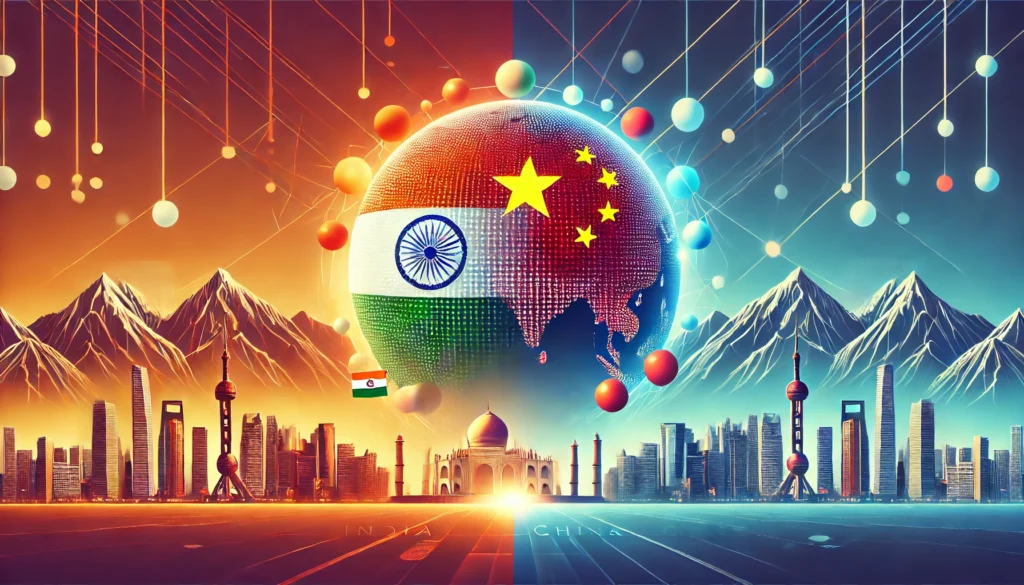Relations between India and China have always had the nature of being inextricably interlaced as a web of cooperation and competition. Both countries hold the position of being very ancient civilizations and new rising world powers. In an address recently, India’s External Affairs Minister (EAM) Dr. S. Jaishankar emphasized that it is “a question of sustaining the complex equilibrium” in bilateral ties. He added, both nations will find ways to co-exist and be alive.
This blog explores the underlying dynamics that make up this complex equation, factors that could influence this engagement, and possible trajectories of future engagement between two Asian giants.
A Historical Context
India and China have an almost historical, geographical, and cultural relationship deeply ingrained. These two nations have been very closely connected in ancient trade routes like the Silk Road and culture, especially Buddhism. However, the modern India-China relationship is marked by challenges, at least since the 1962 war that left a deep impact on their bilateral dynamics.
Despite these failures, both countries have intermittently tried to warm up the relationship through diplomatic gestures and regional cooperation. However, the relationship is still fragile, as it is easily broken by border disputes, strategic competition, and differing global outlooks.
The Concept of “Complex Equilibrium”
Dr. S. Jaishankar’s call for a “complex equilibrium” appropriately captures the nuances of India-China relations. It is a term that resonates with the need to balance cooperation in areas of shared interest while exercising strategic caution to manage disagreement.
Economic Interdependence:
Trade between India and China has been relatively on the increase. In 2022, China remained India’s one of the greatest trading partners as the bilaterals went beyond the $135 billion mark. This kind of economic dependence gives the two nations significant reasons not to drag war for extended periods, because it might create chaos for their respective markets.
BORDER DISPUTES SECURITY CONCERNS:
The Line of Actual Control (LAC) has been one of the main flashpoints in India-China relations. Incidents such as the clash in Galwan Valley in 2020 reflect the potential for unresolved border issues to erupt into full-blown confrontations. The comments by Dr. Jaishankar drive home the imperative to settle these disputes through dialogue and avoid having them dominate the entire bilateral agenda.
Regional and Global Geopolitics:
As partners in multilateral forums such as BRICS and the Shanghai Cooperation Organisation (SCO), India and China are collaborating on global issues like climate change, economic stability, and counterterrorism. But the competition for influence in South Asia and the Indo-Pacific region complicates this cooperation.
Challenges to Maintaining Equilibrium
The idea of equilibrium is very appealing, but putting it into practice is quite a difficult task. Some of the pressing challenges include:
- Asymmetry in Power and Perception: China’s economic and military capabilities are much more powerful than India’s, which gives rise to an asymmetry that impacts their bilateral engagement. This asymmetry often leads to mutual mistrust because India perceives China’s actions as hegemonic, and China views India’s regional aspirations with suspicion.
- Border Infrastructure and Military Buildup: The increasing infrastructural development alongside the LAC by the two nations has increased tensions. The rising militarization of border areas indicates a lack of trust, which complicates diplomatic efforts.
- Economic Inequity and Trade Deficit: India’s trade deficit with China is one of the contentious issues as Chinese imports are much more than Indian exports. Economic inequity has sparked debates in India to reduce dependence on Chinese goods and create self-reliance through schemes like Atmanirbhar Bharat.
- Influence in Neighbouring Countries: The Chinese Belt and Road Initiative and further engagement with India’s neighboring countries, Pakistan and Nepal, have worried New Delhi. In this respect, India has also looked forward to further strengthening its relationship with the U.S., Japan, and Australia through forums like the Quad.
Areas for Cooperation
Amidst all these issues, there is a scope for India and China to cooperate towards stability and growth:
- Climate Change and Renewable Energy: Both countries are victims of climate change and have a common interest in shifting to renewable energy. Cooperation in this field can be a stepping stone for closer relations.
- Public Health and Technology: The COVID-19 pandemic has shown the world the need for international cooperation in public health. India and China, as the pharmaceutical and technology capitals of the world, can cooperate on health innovation and pandemic preparedness.
- Cultural and Academic Exchanges: Strengthening cultural exchanges, tourism, and academic partners will help build mutual understanding and trust.
The Road Ahead
The remarks by Dr. S. Jaishankar reflect an understanding that neither India nor China can afford to be prolonging hostility. Both belong to the world’s superpower club and are huge nuclear powers, whose deeds impact regional and global balance.
It lies in incessant dialogue, mutual respect, and pragmatic policymaking. Border disputes need to be sorted out, trade relations needs to be balanced, and multilateral cooperation can only be enhanced.
Yet to achieve a balance of both the countries, it will have to let go historical grievances and strategic rivalries. Military confidence-building measures and high-level diplomatic initiatives will do the trick in getting set a platform for a more stabilized relation.
Conclusion
The India-China relationship is undeniably complex, a mix of cooperation, competition, and conflict. A very realistic approach to navigating these turbulent waters is to maintain a “complex equilibrium” as emphasized by Dr. S. Jaishankar.
While there are certainly challenges, the potential for cooperation in areas such as climate change, public health, and regional stability underscores the importance of finding common ground. In the end, it will be up to the ability of both nations to balance their differences while pursuing common goals.
The journey toward balance of India and China will not be easy but is surely needed for mutual growth and stability of the larger world.



